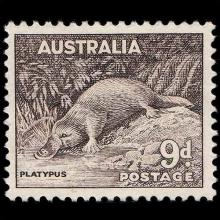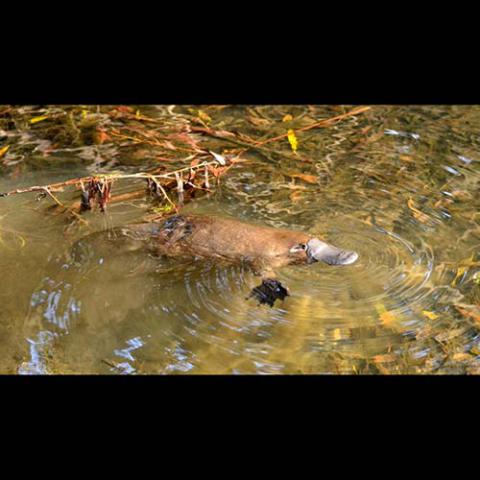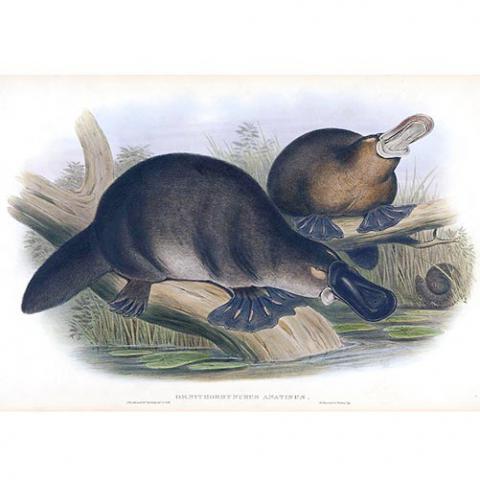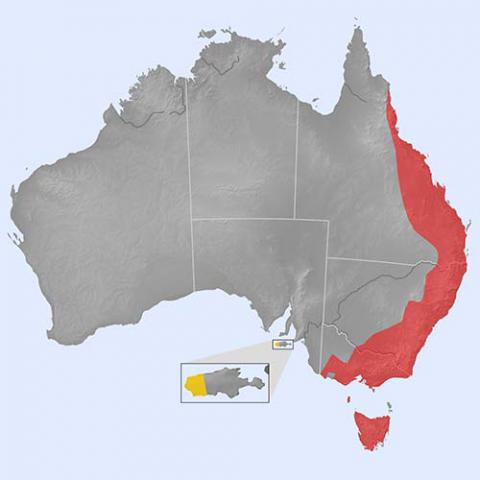NAMES
TAXONOMY
Australia
Issued:
Stamp:
Ornithorhynchus anatinus
Australia
Issued:
Stamp:
Ornithorhynchus anatinus
Australia
Issued:
Stamp:
Ornithorhynchus anatinus
Platypuses Glow Under Blacklight. We Have No Idea Why.
by Cara Giaimo November 13, 2020
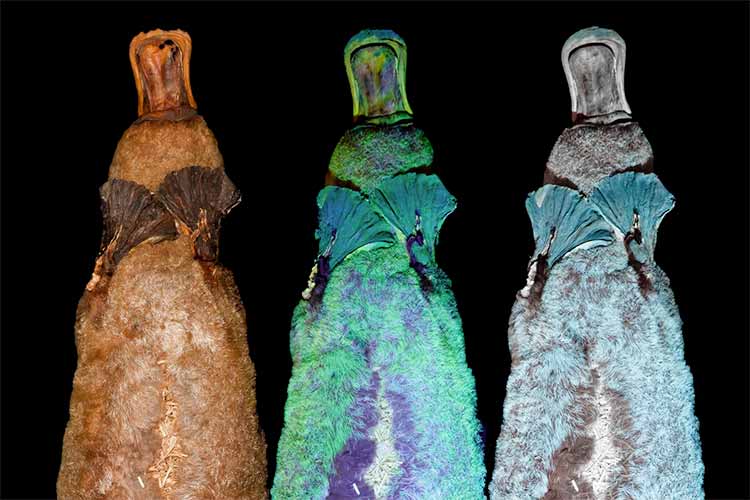
When last we checked on the platypus, it was confounding our expectations of mammals with its webbed feet, duck-like bill and laying of eggs. More than that, it was producing venom.
Now it turns out that even its drab-seeming coat has been hiding a secret — when you turn on the blacklights, it starts to glow.
As noted last month in the journal Mammalia, shining an ultraviolet light on a platypus makes the animal’s fur fluoresce with a greenish-blue tint. They’re one of the few mammals known to exhibit this trait. And we’re still in the dark about why they do it — if there is a reason at all.
For most humans, ultraviolet light exists outside of the visible spectrum. But certain pigments can absorb it, drain off some of its energy, and re-emit what remains as a color that people can see. Many man-made things contain such pigments, including white T-shirts, Froot Loops and petroleum jelly.
A lot of living things do, too. Scorpions, lichens and puffin beaks all pop under UV light. Blue light, which is a notch away from ultraviolet, makes the undersea world look like an indoor mini golf course, and causes dozens of types of amphibians to glow green.
Mammals, though, seem to have generally gotten the short end of this paintbrush: So far, not many have been found to have coats or skin that fluoresce. But there are exceptions, all among nocturnal creatures. In the 1980s, for example, a few researchers uncovered a rainbow of opossums.
Then one night a few years ago, Jonathan Martin, an associate professor of forestry at Northland College in Ashland, Wis., was exploring the woods behind his house with a UV flashlight when he saw that a flying squirrel at his bird feeder appeared bright pink.
Dr. Martin and a few colleagues went to the Field Museum in Chicago to confirm that finding in some preserved specimens. It turns out all three North American flying squirrel species give off a bubble gum glow under UV light.
While they were there, Erik Olson, an associate professor of natural resources at the college, started “wondering how broadly distributed this trait might be,” Dr. Olson said. “Like, what about platypuses? That’s kind of as far from flying squirrels as you can get.”
After checking with the museum’s staff, the team went down to the basement, found the platypus cabinet, and flipped on their special lights. “And sure enough,” Dr. Olson said. They were eventually able to examine three platypuses: a male and a female at the Field Museum, and another male from the University of Nebraska State Museum. All gave off the same cool glow.
So did a road-killed platypus, discovered by a blacklight-wielding mycologist in northeast Australia this summer. Despite the sad circumstances of the finding, “we were elated to know that it was verified in a wild specimen,” Dr. Olson said.
So why would a platypus fluoresce?
“We really don’t know,” Dr. Olson said.
Other instances of life-form Lite Brite serve a clear purpose. Bioluminescence, for example, helps ocean creatures lure prey and find each other in the depths. And hummingbirds get information from the ultraviolet hues that some flowers reflect.
Fluorescence, though, is a bit more opaque. Because it’s a natural property of certain materials, “just finding fluorescence doesn’t mean it has any particular purpose,” said Sönke Johnsen, a sensory biologist at Duke University who was not involved with the study. Instead, he said, that glow could be incidental — “just something that’s there because it’s there.”
It’s unknown whether platypuses can perceive either UV rays or fluorescence, especially in natural light. One theory is that by absorbing and transforming UV light rather than reflecting it, platypuses can better hide from UV-sensitive predators.
But this is just a hypothesis, Dr. Olson said: “Our main goal is to document this trait,” in hopes that future research might shed more light. For now, his group plans to strategically investigate other nocturnal mammals, to see if they can add to their list.
They may have opened a few more museum cabinets already. “Stay tuned,” he said.
Reference: NYTimes.com
Genus species (Animalia): Ornithorhynchus anatinus
The platypus (Ornithorhynchus anatinus), sometimes referred to as the duck-billed platypus, is a semiaquatic, egg-laying mammal endemic to eastern Australia, including Tasmania. The platypus is the sole living representative of its family (Ornithorhynchidae) and genus (Ornithorhynchus), though a number of related species appear in the fossil record.
Together with the four species of echidna, it is one of the five extant species of monotremes, the only mammals that lay eggs instead of giving birth to live young. Like other monotremes, it senses prey through electrolocation. It is one of the few species of venomous mammals, as the male platypus has a spur on the hind foot that delivers a venom, capable of causing severe pain to humans. The unusual appearance of this egg-laying, duck-billed, beaver-tailed, otter-footed mammal baffled European naturalists when they first encountered it, and the first scientists to examine a preserved platypus body (in 1799) judged it a fake, made of several animals sewn together.
The unique features of the platypus make it an important subject in the study of evolutionary biology, and a recognisable and iconic symbol of Australia. It is culturally significant to several Aboriginal peoples of Australia, who also used to hunt the animal for food. It has appeared as a mascot at national events and features on the reverse of the Australian twenty-cent coin, and the platypus is the animal emblem of the state of New South Wales. Until the early 20th century, humans hunted the platypus for its fur, but it is now protected throughout its range. Although captive-breeding programs have had only limited success, and the platypus is vulnerable to the effects of pollution, it is not under any immediate threat.
As of 2020, the platypus is a legally protected species in all states where it occurs, but it only listed as an endangered species in South Australia. The species is classified as a near-threatened species by the IUCN, but a November 2020 report has recommended that it is upgraded to threatened species under the federal EPBC Act, due to habitat destruction and declining numbers in all states.
Taxonomy and etymology
When the platypus was first encountered by Europeans in 1798, a pelt and sketch were sent back to Great Britain by Captain John Hunter, the second Governor of New South Wales. British scientists' initial hunch was that the attributes were a hoax. George Shaw, who produced the first description of the animal in the Naturalist's Miscellany in 1799, stated it was impossible not to entertain doubts as to its genuine nature, and Robert Knox believed it might have been produced by some Asian taxidermist. It was thought that somebody had sewn a duck's beak onto the body of a beaver-like animal. Shaw even took a pair of scissors to the dried skin to check for stitches.
The common name "platypus" is the latinisation of the Greek word πλατύπους (platupous), "flat-footed", from πλατύς (platus), "broad, wide, flat" and πούς (pous), "foot". Shaw assigned the species the Linnaean name Platypus anatinus when he initially described it, but the genus term was quickly discovered to already be in use as the name of the wood-boring ambrosia beetle genus Platypus. It was independently described as Ornithorhynchus paradoxus by Johann Blumenbach in 1800 (from a specimen given to him by Sir Joseph Banks) and following the rules of priority of nomenclature, it was later officially recognised as Ornithorhynchus anatinus. The scientific name Ornithorhynchus anatinus is derived from ορνιθόρυγχος (ornithorhynkhos), which literally means "bird snout" in Greek; and anatinus, which means "duck-like" in Latin.
There is no universally-agreed plural form of "platypus" in the English language. Scientists generally use "platypuses" or simply "platypus". Colloquially, the term "platypi" is also used for the plural, although this is a form of pseudo-Latin; going by the word's Greek roots the plural would be "platypodes". Early British settlers called it by many names, such as "watermole", "duckbill", and "duckmole". The name "platypus" is occasionally prefixed with the adjective "duck-billed" to form "duck-billed platypus".
Description
In David Collins's account of the new colony 1788–1801, he describes coming across "an amphibious animal, of the mole species". His account includes a drawing of the animal.
The body and the broad, flat tail of the platypus are covered with dense, brown, biofluorescent fur that traps a layer of insulating air to keep the animal warm. The fur is waterproof, and the texture is akin to that of a mole. The platypus uses its tail for storage of fat reserves (an adaptation also found in animals such as the Tasmanian devil). The webbing on the feet is more significant on the front feet and is folded back when walking on land. The elongated snout and lower jaw are covered in soft skin, forming the bill. The nostrils are located on the dorsal surface of the snout, while the eyes and ears are located in a groove set just back from it; this groove is closed when swimming. Platypuses have been heard to emit a low growl when disturbed and a range of other vocalisations have been reported in captive specimens.
Weight varies considerably from 0.7 to 2.4 kg (1 lb 9 oz to 5 lb 5 oz), with males being larger than females. Males average 50 cm (20 in) in total length, while females average 43 cm (17 in), with substantial variation in average size from one region to another. This pattern does not seem to follow any particular climatic rule and may be due to other environmental factors, such as predation and human encroachment.
The platypus has an average body temperature of about 32 °C (90 °F) rather than the 37 °C (99 °F) typical of placental mammals. Research suggests this has been a gradual adaptation to harsh environmental conditions on the part of the small number of surviving monotreme species rather than a historical characteristic of monotremes.
Modern platypus young have three teeth in each of the maxillae (one premolar and two molars) and dentaries (three molars), which they lose before or just after leaving the breeding burrow; adults have heavily keratinised pads in their place. The first upper and third lower cheek teeth of platypus nestlings are small, each having one principal cusp, while the other teeth have two main cusps. The platypus jaw is constructed differently from that of other mammals, and the jaw-opening muscle is different. As in all true mammals, the tiny bones that conduct sound in the middle ear are fully incorporated into the skull, rather than lying in the jaw as in pre mammalian synapsids. However, the external opening of the ear still lies at the base of the jaw. The platypus has extra bones in the shoulder girdle, including an interclavicle, which is not found in other mammals. As in many other aquatic and semiaquatic vertebrates, the bones show osteosclerosis, increasing their density to provide ballast. It has a reptilian gait, with the legs on the sides of the body, rather than underneath. When on land, it engages in knuckle-walking on its front feet, to protect the webbing between the toes.
Reference: Wikipedia

